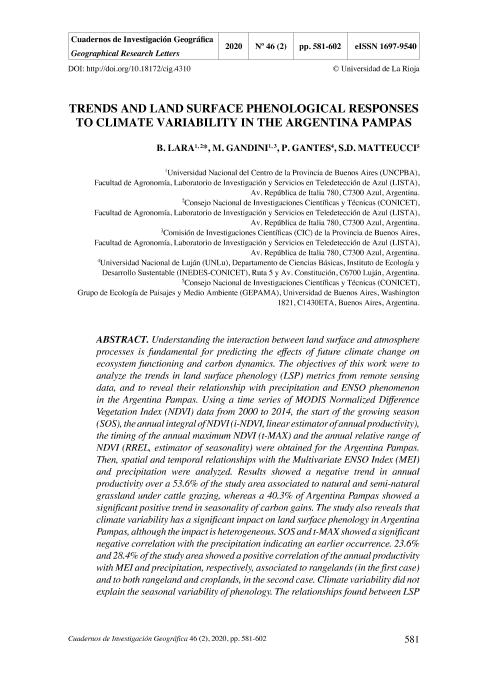Artículo
Comprender la interacción entre los procesos de la superficie terrestre y la atmósfera es fundamental para predecir los efectos del cambio climático futuro sobre el funcionamiento de los ecosistemas y la dinámica del carbono. Los objetivos de este trabajo fueron analizar las tendencias en métricas de la fenología de la superficie terrestre derivadas de sensores remotos, y revelar su relación con la precipitación y el fenómeno ENSO en la región pampeana de Argentina. A partir de una serie temporal de imágenes del Índice de Vegetación de Diferencia Normalizada (NDVI) de MODIS para el período 2000-2014, se obtuvo para la región pampeana de Argentina el inicio de la estación de crecimiento (SOS), la integral anual del NDVI (i-NDVI, estimador lineal de la productividad anual), el tiempo del máximo anual del NDVI (t-MAX) y el rango relativo anual de NDVI (RREL, estimador de la estacionalidad). Posteriormente, se analizaron las relaciones espaciales y temporales con el Índice Multivariado del ENSO (MEI) y la precipitación. Los resultados mostraron una tendencia negativa en la productividad anual en un 53,6% del área de estudio asociado a zonas de pastizales naturales y semi-naturales, mientras que un 40,3% de la Pampa Argentina mostró una tendencia positiva significativa en la estacionalidad de las ganancias de carbono. Este estudio también revela que la variabilidad climática tiene un impacto significativo en la fenología de la superficie terrestre de la región pampeana, aunque este impacto es heterogéneo. SOS y t-MAX mostraron una correlación negativa significativa con la precipitación, lo que indica una ocurrencia más temprana. El 23,6% y 28,4% del área de estudio mostró una correlación positiva de la productividad anual con el MEI y la precipitación, respectivamente, asociado a pastizales (en el primer caso) y sobre pastizales y áreas agrícolas en el segundo caso. La variabilidad climática no explicó la variabilidad en la estacionalidad de la fenología. Las relaciones encontradas entre las métricas de la fenología de la superficie terrestre y la variabilidad climática podrían ser importantes para la implementación de estrategias para el manejo de los recursos naturales. Understanding the interaction between land surface and atmosphere processes is fundamental for predicting the effects of future climate change on ecosystem functioning and carbon dynamics. The objectives of this work were to analyze the trends in land surface phenology (LSP) metrics from remote sensing data, and to reveal their relationship with precipitation and ENSO phenomenon in the Argentina Pampas. Using a time series of MODIS Normalized Difference Vegetation Index (NDVI) data from 2000 to 2014, the start of the growing season (SOS), the annual integral of NDVI (i-NDVI, linear estimator of annual productivity), the timing of the annual maximum NDVI (t-MAX) and the annual relative range of NDVI (RREL, estimator of seasonality) were obtained for the Argentina Pampas. Then, spatial and temporal relationships with the Multivariate ENSO Index (MEI) and precipitation were analyzed. Results showed a negative trend in annual productivity over a 53.6% of the study area associated to natural and semi-natural grassland under cattle grazing, whereas a 40.3% of Argentina Pampas showed a significant positive trend in seasonality of carbon gains. The study also reveals that climate variability has a significant impact on land surface phenology in Argentina Pampas, although the impact is heterogeneous. SOS and t-MAX showed a significant negative correlation with the precipitation indicating an earlier occurrence. 23.6% and 28.4% of the study area showed a positive correlation of the annual productivity with MEI and precipitation, respectively, associated to rangelands (in the first case) and to both rangeland and croplands, in the second case. Climate variability did not explain the seasonal variability of phenology. The relationships found between LSP metrics and climate variability could be important for implementation of strategies for natural resource management.
Trends and land surface phenological responses to climate variability in the Argentina Pampas
Título:
Tendencias y respuestas de la fenología de la superficie terrestre a la variabilidad climática en la Pampa Argentina
Fecha de publicación:
01/2020
Editorial:
Universidad de La Rioja
Revista:
Cuadernos de Investigación Geográfica
ISSN:
0211-6820
e-ISSN:
1697-9540
Idioma:
Inglés
Tipo de recurso:
Artículo publicado
Clasificación temática:
Resumen
Archivos asociados
Licencia
Identificadores
Colecciones
Articulos(CCT - TANDIL)
Articulos de CTRO CIENTIFICO TECNOLOGICO CONICET - TANDIL
Articulos de CTRO CIENTIFICO TECNOLOGICO CONICET - TANDIL
Citación
Lara, Bruno Daniel; Gandini, M.; Gantes, P.; Matteucci, Silvia Diana; Trends and land surface phenological responses to climate variability in the Argentina Pampas; Universidad de La Rioja; Cuadernos de Investigación Geográfica; 46; 2; 1-2020; 581-602
Compartir
Altmétricas




